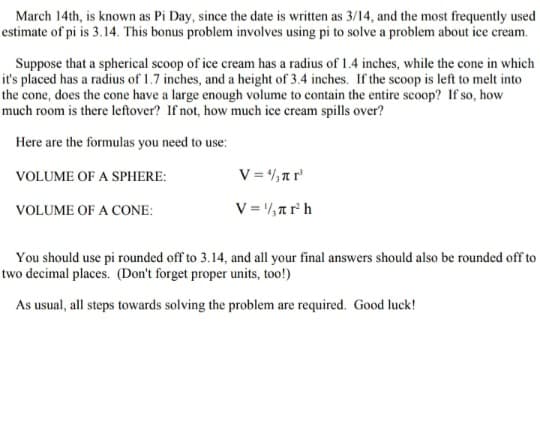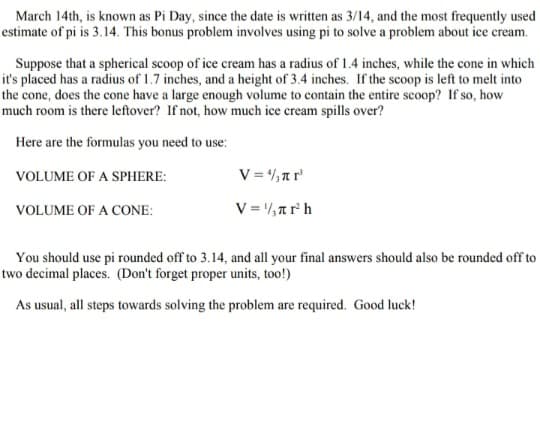March 14th, is known as Pi Day, since the date is written as 3/14, and the most frequently used estimate of pi is 3.14. This bonus problem involves using pi to solve a problem about ice cream. Suppose that a spherical scoop of ice cream has a radius of 1.4 inches, while the cone in which it's placed has a radius of 1.7 inches, and a height of 3.4 inches. If the scoop is left to melt into the cone, does the cone have a large enough volume to contain the entire scoop? If so, how much room is there leftover? If not, how much ice cream spills over? Here are the formulas you need to use: VOLUME OF A SPHERE: VOLUME OF A CONE: V=%,r² V = ₁r²h You should use pi rounded off to 3.14, and all your final answers should also be rounded off to two decimal places. (Don't forget proper units, too!) As usual, all steps towards solving the problem are required. Good luck!
March 14th, is known as Pi Day, since the date is written as 3/14, and the most frequently used estimate of pi is 3.14. This bonus problem involves using pi to solve a problem about ice cream. Suppose that a spherical scoop of ice cream has a radius of 1.4 inches, while the cone in which it's placed has a radius of 1.7 inches, and a height of 3.4 inches. If the scoop is left to melt into the cone, does the cone have a large enough volume to contain the entire scoop? If so, how much room is there leftover? If not, how much ice cream spills over? Here are the formulas you need to use: VOLUME OF A SPHERE: VOLUME OF A CONE: V=%,r² V = ₁r²h You should use pi rounded off to 3.14, and all your final answers should also be rounded off to two decimal places. (Don't forget proper units, too!) As usual, all steps towards solving the problem are required. Good luck!
Mathematics For Machine Technology
8th Edition
ISBN:9781337798310
Author:Peterson, John.
Publisher:Peterson, John.
Chapter59: Areas Of Rectangles, Parallelograms, And Trapezoids
Section: Chapter Questions
Problem 79A
Related questions
Question
Help

Transcribed Image Text:March 14th, is known as Pi Day, since the date is written as 3/14, and the most frequently used
estimate of pi is 3.14. This bonus problem involves using pi to solve a problem about ice cream.
Suppose that a spherical scoop of ice cream has a radius of 1.4 inches, while the cone in which
it's placed has a radius of 1.7 inches, and a height of 3.4 inches. If the scoop is left to melt into
the cone, does the cone have a large enough volume to contain the entire scoop? If so, how
much room is there leftover? If not, how much ice cream spills over?
Here are the formulas you need to use:
VOLUME OF A SPHERE:
VOLUME OF A CONE:
V=%,r²
V = ₁r²h
You should use pi rounded off to 3.14, and all your final answers should also be rounded off to
two decimal places. (Don't forget proper units, too!)
As usual, all steps towards solving the problem are required. Good luck!

Transcribed Image Text:March 14th, is known as Pi Day, since the date is written as 3/14, and the most frequently used
estimate of pi is 3.14. This bonus problem involves using pi to solve a problem about ice cream.
Suppose that a spherical scoop of ice cream has a radius of 1.4 inches, while the cone in which
it's placed has a radius of 1.7 inches, and a height of 3.4 inches. If the scoop is left to melt into
the cone, does the cone have a large enough volume to contain the entire scoop? If so, how
much room is there leftover? If not, how much ice cream spills over?
Here are the formulas you need to use:
VOLUME OF A SPHERE:
VOLUME OF A CONE:
V=%,r²
V = ₁r²h
You should use pi rounded off to 3.14, and all your final answers should also be rounded off to
two decimal places. (Don't forget proper units, too!)
As usual, all steps towards solving the problem are required. Good luck!
Expert Solution
This question has been solved!
Explore an expertly crafted, step-by-step solution for a thorough understanding of key concepts.
This is a popular solution!
Trending now
This is a popular solution!
Step by step
Solved in 2 steps with 1 images

Recommended textbooks for you

Mathematics For Machine Technology
Advanced Math
ISBN:
9781337798310
Author:
Peterson, John.
Publisher:
Cengage Learning,

Elementary Geometry For College Students, 7e
Geometry
ISBN:
9781337614085
Author:
Alexander, Daniel C.; Koeberlein, Geralyn M.
Publisher:
Cengage,

Algebra & Trigonometry with Analytic Geometry
Algebra
ISBN:
9781133382119
Author:
Swokowski
Publisher:
Cengage

Mathematics For Machine Technology
Advanced Math
ISBN:
9781337798310
Author:
Peterson, John.
Publisher:
Cengage Learning,

Elementary Geometry For College Students, 7e
Geometry
ISBN:
9781337614085
Author:
Alexander, Daniel C.; Koeberlein, Geralyn M.
Publisher:
Cengage,

Algebra & Trigonometry with Analytic Geometry
Algebra
ISBN:
9781133382119
Author:
Swokowski
Publisher:
Cengage